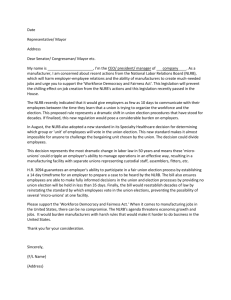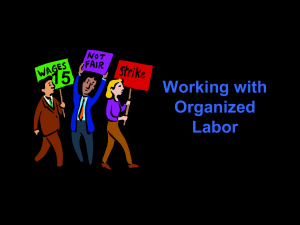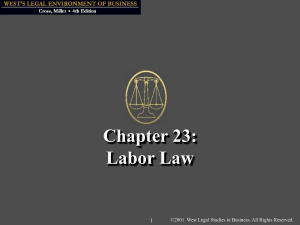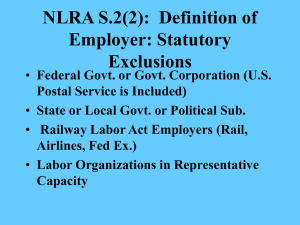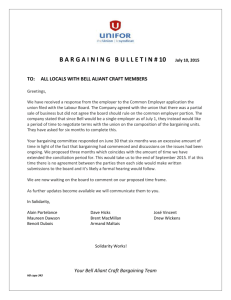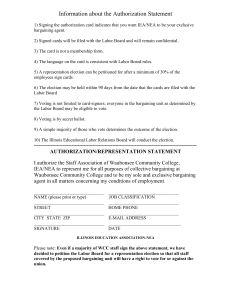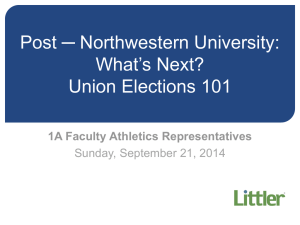Lecture for 11/1
advertisement
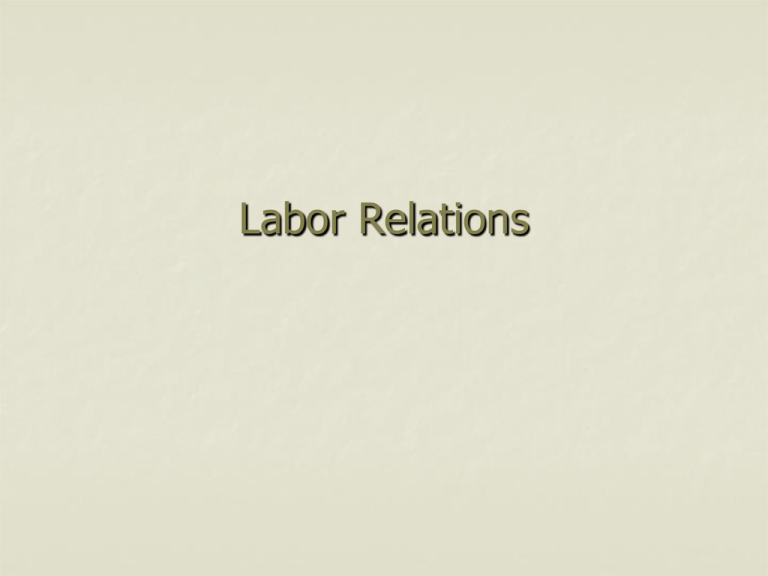
Labor Relations Test Your Labor Relations Know-How 1. An auto mechanic applied for a job with an automotive dealership. He was denied employment because of his union membership. Was the employer’s action lawful? ______ Yes ______ No 2. During a labor organizing drive, supervisors questioned individual employees about their union beliefs. Was this questioning permissible? ______ Yes ______ No 3. When members of a union began wearing union buttons at work, management ordered the buttons to be removed. Was management within its rights? ______ Yes ______ No 4. While an organizing drive was under way, an employer agreed—as a social gesture—to furnish refreshments at a holiday party. Was the employer acting within the law? ______ Yes ______ No 5. A company distributed to other antiunion employers in the area a list of job applicants known to be union supporters. Was the distribution unlawful? ______ Yes ______ No 6. During a union organizing drive, the owner of Servo Pipe promised her employees a wage increase if they would vote against the union. Can the owner legally make this promise to her employees? ______ Yes ______ No Test Your Labor Relations Know-How (cont’d) 7. Employees have the right to file unfair labor practice charges against their employer even when the organization is nonunion. ______ Yes ______ No 8. The union wishes to arbitrate a member’s grievance, which management has demonstrated is completely groundless. Must management arbitrate the grievance? ______ Yes ______ No 9. John Green, a maintenance engineer, has a poor work record. Management wishes to terminate his employment. However, Green is a union steward, and he is highly critical of the company. Can management legally discharge this employee? ______ Yes ______ No 10. During an organizing drive, an office manager expressed strong antiunion beliefs and called union officials “racketeers,” “big stinkers,” and a “bunch of radicals.” He told employees who joined the union that they “ought to have their heads examined.” Were the manager’s comments legal? ______ Yes ______ No Impact of Unions Staffing Employee Development Compensation Employee Relations Major Labor Laws Railway Labor Act (RLA) of 1926 Norris LaGuardia Act (Anti-Injunction Act) Wagner Act (National labor Relations Act) of 1935 Taft-Harley Act (Labor-Management Relations Act) of 1947 Landrum-Griffin Act (Labor-Management Disclosure Act) of 1959 Government Regulation of Labor Relations Railway Labor Act (RLA) of 1926 Purpose of the act is to avoid service interruptions resulting from disputes between railroads and their operating unions. National Mediation Board National Railway Adjustment Board Norris-LaGuardia Act of 1932 Restricts the ability of employers to obtain an injunction against unions for their lawful activities. Wagner (NLRA) Act Generally applies to all employers involved in interstate commerce other than airlines, railroads, agriculture, and government. Government Regulation of Labor Relations Wagner Act (National Labor Relations Act) of 1935 Protects employee rights to organize and bargain collectively through representatives of their choice. Created the National Labor Relations Board (NLRB) to govern labor relations in the United States. Holds secret ballot union representation elections. Prevents and remedies unfair labor practices. Wagner (NLRA) Act Section 7 of the Act guarantees employee rights: To self-organization, to form, join, or assist labor organizations, to bargain collectively through freely chosen representatives. To engage in concerted activities, for the purpose of collective bargaining or other mutual aid or protection. To refrain from any or all of such activities except to the extent that such right may be affected by an agreement requiring membership in a labor organization as a condition of employment. Unfair Labor Practices (ULPs) Section 8 of the Wagner Act outlawed employer practices that deny employees their rights and benefits: Interference with Section 7 rights Domination of a union (company union) Discrimination against union members Arbitrary discharge of union members Refusal to bargain with the union Amendment to the Wagner Act Taft-Hartley Act (The Labor-Management Relations Act) of 1947 Balances rights and duties of labor and management in collective bargaining by defining unfair union practices. Created the Federal Mediation and Conciliation Service (FMCS) to help resolve negotiating disputes. Unfair Union Practices (TaftHartley Act) Unions are prohibited from: Interfering with Section 7 rights of employees Interfering with representation elections Influencing employers to discriminate with regard to union membership Refusal to bargain collectively with employer Interference with certified employee representative’s relationship with employer Assessment of excessive initiation fees and dues on bargaining unit members Another Amendment to the Wagner Act Landrum-Griffin Act (Labor-Management Reporting and Disclosure Act) of 1959 Safeguards union member rights and prevents racketeering and other unscrupulous practices by employers and union officers. Landrum-Griffen Act of 1959 Each union must have a bill of rights for union members to ensure minimum standards of internal union democracy. Each union must adopt a constitution and provide copies of it to the Department of Labor. Each union must report its financial activities and the financial interests of its leaders to the Department of Labor. Union elections are regulated by the government, and union members have the right to participate in secret ballot elections. Union leaders have fiduciary responsibility to not use union money and property for their own personal gain. The Labor Relations Process Why Employees Unionize United Food and Commercial Workers International Union Authorization Card Aggressive Organizing Tactics Political Involvement Neutrality Agreements Organizer Training Corporate Campaigns Information Technology Union NOW!! OUR CONCERNS UNION NO UNION Wages and Other Compensation. Spelled out in the Contract SECRET - privately negotiated by management. Raises. Will be bargained for everyone and everyone votes. Favoritism can determine individual raises. Discipline/Dismissal. The Union will defend you with Legal Assistance and a Grievance Process. You are an "AT WILL" employee. Good luck, you're on your own. Problems on the Job. Your VOICE is heard. You Their way or the have a Grievance highway. Process. Service Employees International Union Employer Tactics Opposing Unionization Stressing favorable employer-employee relationship experienced without a union. Emphasize current advantages in wages, benefits, or working conditions the employees may enjoy Emphasize unfavorable aspects of unionism: strikes, union dues, abuses of legal rights Initiate legal action when union members and leaders engage in unfair labor practices TIPS for Pre-election Conduct Threats It is unlawful to threaten employees with theoretical dire consequences should the union win the election. Intimidation Employers by law cannot intimidate or coerce employees to vote against the union. Promises Management cannot promise employees benefits or reward if they vote against the union. Surveillance It is unlawful to secretly or overtly spy on organizing meetings. The Labor Relations Process 1. Union organizing Demonstrating interest NLRB Election 2. Collective bargaining “Good faith” bargaining 3. Contract administration Hiring, training, and job design Grievance procedures How Employees Become Unionized Bargaining Unit A group of two or more employees who share common employment interests and conditions and may reasonably be grouped together for purposes of collective bargaining. Exclusive Representation The legal right and responsibility of the union to represent all bargaining unit members equally, regardless of whether employees join the union or not. Union Organizing Process Showing interest NLRB requires 30% of employees sign authorization cards to conduct an election. Election petition filed The Local presents the cards to the NLRB with a request that it conduct an election. Election date set The union, an employer representative, and the NLRB set an election date. NLRB election (secret ballot) Employees decide by a secret ballot if you want a union to begin negotiations with your employer. NLRB Representation Election Representation Election Process Preelection Hearing: Election: NLRB certifies that 30 percent of eligible employees in bargaining unit have signed authorization cards and sets date for election. NLRB conducts secret ballot election. If union wins the majority of votes in the election, NLRB certifies the union as the exclusive bargaining unit representative with which the employer must collectively bargain. Certification on Card Check: If at least 50 percent of employees within the bargaining unit sign authorization cards, then the union may request recognition by the employer.
